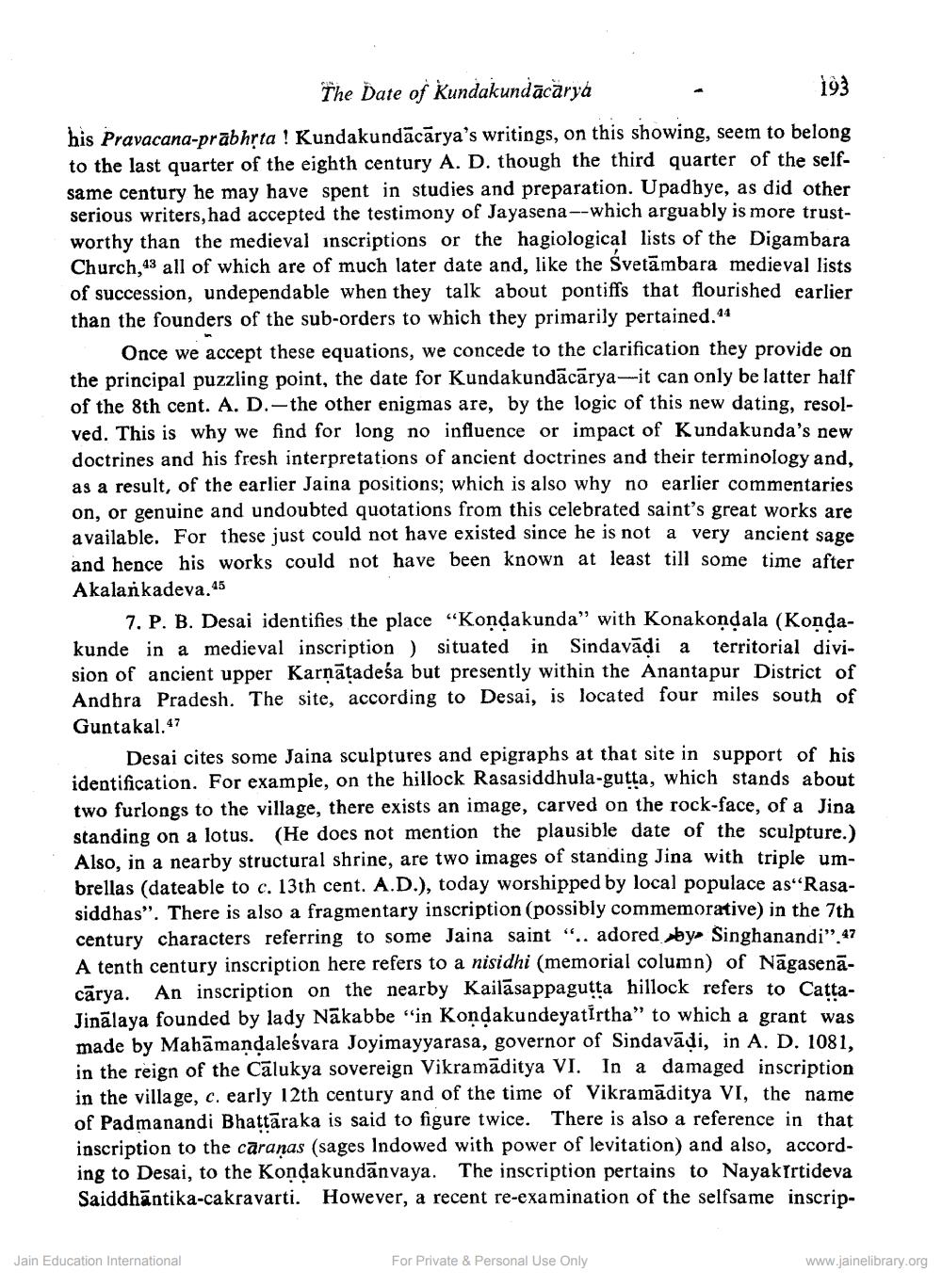Book Title: Date of Kundakundacharya Author(s): M A Dhaky Publisher: Z_Aspect_of_Jainology_Part_3_Pundit_Dalsukh_Malvaniya_012017.pdf View full book textPage 7
________________ 193 The Date of Kundakundācārya his Pravacana-prābhrta ! Kundakundācārya's writings, on this showing, seem to belong to the last quarter of the eighth century A. D. though the third quarter of the selfsame century he may have spent in studies and preparation. Upadhye, as did other serious writers, had accepted the testimony of Jayasena --which arguably is more trustworthy than the medieval inscriptions or the hagiological lists of the Digambara Church, 43 all of which are of much later date and, like the Svetāmbara medieval lists of succession, undependable when they talk about pontiffs that flourished earlier than the founders of the sub-orders to which they primarily pertained. 44 Once we accept these equations, we concede to the clarification they provide on the principal puzzling point, the date for Kundakundācārya-it can only be latter half of the 8th cent. A. D.- the other enigmas are, by the logic of this new dating, resolved. This is why we find for long no influence or impact of Kundakunda's new doctrines and his fresh interpretations of ancient doctrines and their terminology and, as a result, of the earlier Jaina positions; which is also why no earlier commentaries on, or genuine and undoubted quotations from this celebrated saint's great works are available. For these just could not have existed since he is not a very ancient sage and hence his works could not have been known at least till some time after Akalankadeva.45 7. P. B. Desai identifies the place "Kondakunda" with Konakondala (Kondakunde in a medieval inscription) situated in Sindavādi a territorial division of ancient upper Karnātadeśa but presently within the Anantapur District of Andhra Pradesh. The site, according to Desai, is located four miles south of Guntakal.47 Desai cites some Jaina sculptures and epigraphs at that site in support of his identification. For example, on the hillock Rasasiddhula-gutta, which stands about two furlongs to the village, there exists an image, carved on the rock-face, of a Jina standing on a lotus. (He does not mention the plausible date of the sculpture.) Also, in a nearby structural shrine, are two images of standing Jina with triple umbrellas (dateable to c. 13th cent. A.D.), today worshipped by local populace as"Rasasiddhas". There is also a fragmentary inscription (possibly commemorative) in the 7th century characters referring to some Jaina saint ".. adored by Singhanandi”. 47 A tenth century inscription here refers to a nisidhi (memorial column) of Nāgasenācārya. An inscription on the nearby Kailāsappagutta hillock refers to CattaJinālaya founded by lady Nākabbe "in Kondakundeyatirtha" to which a grant was made by Mahamandalesvara Joyimayyarasa, governor of Sindavādi, in A. D. 1081. in the reign of the Calukya sovereign Vikramāditya VI. In a damaged inscription in the village, c. early 12th century and of the time of Vikramāditya VI, the name of Padmanandi Bhattāraka is said to figure twice. There is also a reference in that inscription to the cāraṇas (sages Indowed with power of levitation) and also, according to Desai, to the Kondakundānvaya. The inscription pertains to Nayak Irtideva Saiddhāntika-cakravarti. However, a recent re-examination of the selfsame inscrip Jain Education International For Private & Personal Use Only www.jainelibrary.orgPage Navigation
1 ... 5 6 7 8 9 10 11 12 13 14 15 16 17 18 19 20
